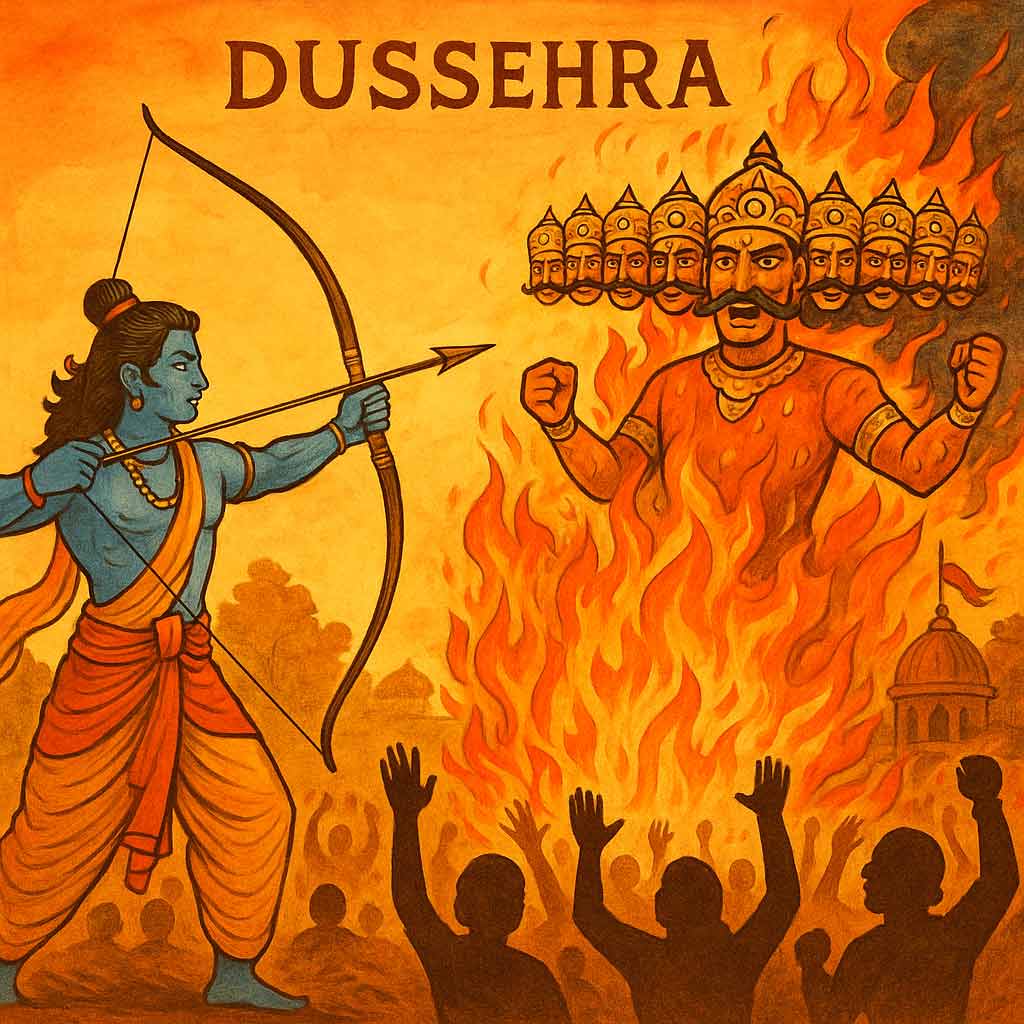Dussehra(September–October)
The Triumph of Good over Evil

Dussehra, also known as Vijayadashami, is one of the most significant Hindu festivals celebrated across India with great enthusiasm and spiritual fervour. It marks the victory of good over evil and righteousness over wickedness. Falling on the tenth day of the lunar month of Ashwin (September–October), it comes right after the nine days of Navratri and carries deep cultural, moral, and spiritual meanings. The word Dussehra is derived from two Sanskrit words — Dasha meaning “ten” and Hara meaning “defeat” — signifying the defeat of the ten-headed demon king Ravana by Lord Rama, as narrated in the epic Ramayana.
The story of Dussehra varies slightly across regions, but the central theme remains the same — the triumph of virtue over vice. In northern India, Dussehra commemorates Lord Rama’s victory over Ravana, who had abducted his wife Sita. It is said that after a fierce battle lasting ten days, Rama killed Ravana and rescued Sita, symbolizing the triumph of truth and dharma. In many parts of the country, effigies of Ravana, his brother Kumbhakarna, and his son Meghnath are burned in open grounds to celebrate this victory. The burning effigies, accompanied by the thunderous sound of firecrackers, signify the destruction of arrogance, lust, and evil tendencies that reside within human beings. The festival teaches that even the mightiest power cannot stand against truth and righteousness.
In the eastern and southern states of India, Dussehra coincides with the conclusion of Durga Puja, a grand celebration that honours Goddess Durga’s victory over the buffalo demon Mahishasura. According to Hindu mythology, Mahishasura was a powerful demon who had gained immense strength and created havoc in the heavens and on earth. The gods combined their energies to create Goddess Durga, who fought Mahishasura for nine days and nights and finally defeated him on the tenth day — celebrated as Vijayadashami, the day of victory. Thus, while northern India celebrates Dussehra as Rama’s victory, eastern and southern India celebrate it as the triumph of the Goddess over demonic forces. Both stories, however, convey the same eternal message — the ultimate triumph of good over evil.
The festival also carries immense cultural and social significance. In many towns and villages, theatrical enactments of the Ramayana known as Ramlila are performed in open-air stages. These performances not only entertain but also serve as moral education, reminding people of the values of truth, honour, and sacrifice. The effigy-burning ceremonies bring together people from all walks of life, reinforcing a sense of community and shared celebration. In the south, devotees mark the day by beginning new ventures, buying new tools, books, or vehicles, as it is considered an auspicious time for new beginnings. The tradition of worshipping tools and instruments, known as Ayudha Puja, signifies respect for one’s profession and work.
Beyond mythology and ritual, Dussehra also holds philosophical depth. It is a reminder that evil is not merely external — represented by Ravana or Mahishasura — but also resides within us in the form of ego, greed, anger, jealousy, and deceit. The burning of Ravana’s effigy symbolizes the burning of these inner vices. Every year, the festival encourages individuals to introspect and strive to conquer their personal demons.
Dussehra’s universal appeal lies in its message of moral victory and renewal. It inspires courage, righteousness, and the confidence that truth will always prevail, no matter how powerful evil may appear. In a modern world often filled with conflict, inequality, and moral confusion, Dussehra serves as a timeless reminder that ethical living, compassion, and self-discipline form the foundation of a just and harmonious society.
In essence, Dussehra is not just a festival; it is a celebration of human values — courage, truth, justice, and devotion. It teaches that no matter how many challenges or injustices one faces, righteousness and goodness will ultimately triumph. As the flames of Ravana’s effigy rise high into the night sky, they illuminate not only the end of evil but also the dawn of hope, virtue, and moral awakening — a lesson that remains as relevant today as it was thousands of years ago.
